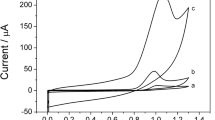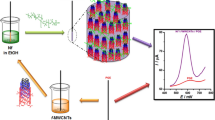Abstract
In this work, the batch injection analysis system with amperometric detection using reduced graphene oxide as a modifier of glassy carbon electrode (GCE) was investigated for the simple, fast, and sensitive monitoring of levofloxacin (LEVO) and ciprofloxacin (CIPRO) in samples of pharmaceutical formulations, synthetic urine, and milk (low- and high-fat content). LEVO and CIPRO were quantified in seven samples using amperometric measurements at +1.10 V vs Ag/AgCl, KCl(sat). The developed methods showed excellent analytical performance with limits of detection of 0.30 and 0.16 μmol L−1, linear range from 3.0 to 50 μmol L−1 and 1.0 to 50 μmol L−1, relative standard deviation below 9.7 and 3.1%, and recovery ranges ranging from 80 to 107% and from 78 to 109% for LEVO and CIPRO, respectively. In addition, the minimum sample preparation (simple dilution) combined with a high analytical frequency (130 to 180 analyses per hour) can be highlighted. Thus, the methods are promising for implementation in routine analysis and quality control to different samples.
Graphical abstract






Similar content being viewed by others
References
Abukhadra MR, Helmy A, Sharaf MF, El-Meligy MA, Ahmed Soliman AT. Instantaneous oxidation of levofloxacin as toxic pharmaceutical residuals in water using clay nanotubes decorated by ZnO (ZnO/KNTs) as a novel photocatalyst under visible light source. J Env Manag. 2020;271:111019. https://doi.org/10.1016/j.jenvman.2020.111019.
de Farias DM, de Faria LV, Lisboa TP, Matos MAC, Muñoz RAA, Matos RC. Determination of levofloxacin in pharmaceutical formulations and urine at reduced graphene oxide and carbon nanotube-modified electrodes. J Solid State Electrochem. 2020;24(5):1165–73. https://doi.org/10.1007/s10008-020-04589-z.
de Faria LV, Lisboa TP, Alves GF, de Farias DM, Matos MAC, Muñoz RAA, et al. Electrochemical study of different sensors for simple and fast quantification of ciprofloxacin in pharmaceutical formulations and bovine milk. Electroanal. 2020;32(10):2266–72. https://doi.org/10.1002/elan.202060211.
Sinha RK, Biswas P. Structural elucidation of levofloxacin and ciprofloxacin using density functional theory and Raman spectroscopy with inexpensive lab-built setup. J Molec Struc. 2020;1222:128946. https://doi.org/10.1016/j.molstruc.2020.128946.
Adhikari S, Mandal S, Kim D-H. Z-scheme 2D/1D MoS2 nanosheet-decorated Ag2Mo2O7 microrods for efficient catalytic oxidation of levofloxacin. Chem Eng J. 2019;373:31–43. https://doi.org/10.1016/j.cej.2019.05.017.
Ghanbari MH, Khoshroo A, Sobati H, Ganjali MR, Rahimi-Nasrabadi M, Ahmadi F. An electrochemical sensor based on poly (l-cysteine)@AuNPs @ reduced graphene oxide nanocomposite for determination of levofloxacin. Microchem J. 2019;147:198–206. https://doi.org/10.1016/j.microc.2019.03.016.
Rudnicki K, Sipa K, Brycht M, Borgul P, Skrzypek S, Poltorak L. Electrochemical sensing of fluoroquinolone antibiotics. TrAC Trends in Anal Chem. 2020;128:115907. https://doi.org/10.1016/j.trac.2020.115907.
Wang A, Chen Z, Zheng Z, Xu H, Wang H, Hu K, et al. Remarkably enhanced sulfate radical-based photo-Fenton-like degradation of levofloxacin using the reduced mesoporous MnO@MnOx microspheres. Chem Eng J. 2020;379:122340. https://doi.org/10.1016/j.cej.2019.122340.
Wong A, Santos AM, Fatibello-Filho O. Simultaneous determination of paracetamol and levofloxacin using a glassy carbon electrode modified with carbon black, silver nanoparticles and PEDOT:PSS film. Sens Actuat B: Chem. 2018;255:2264–73. https://doi.org/10.1016/j.snb.2017.09.020.
Cesarino V, Cesarino I, Moraes FC, Machado SAS, Mascaro LH. Carbon nanotubes modified with SnO2 rods for levofloxacin detection. J Braz Chem Soc. 2014;25:502–8.
Moraes FC, Silva TA, Cesarino I, Lanza MRV, Machado SAS. Antibiotic detection in urine using electrochemical sensors based on vertically aligned carbon nanotubes. Electroanal. 2013;25(9):2092–9. https://doi.org/10.1002/elan.201300261.
Vella J, Busuttil F, Bartolo NS, Sammut C, Ferrito V, Serracino-Inglott A, et al. A simple HPLC–UV method for the determination of ciprofloxacin in human plasma. J Chromatogr B. 2015;989:80–5. https://doi.org/10.1016/j.jchromb.2015.01.006.
Locatelli M, Ciavarella MT, Paolino D, Celia C, Fiscarelli E, Ricciotti G, et al. Determination of ciprofloxacin and levofloxacin in human sputum collected from cystic fibrosis patients using microextraction by packed sorbent-high performance liquid chromatography photodiode array detector. J Chromatogr A. 2015;1419:58–66. https://doi.org/10.1016/j.chroma.2015.09.075.
Tsai Y-H, Bair M-J, Hu C-C. Determination of levofloxacin in human urine with capillary electrophoresis and fluorescence detector. J Chin Chem Soc. 2007;54(4):991–5. https://doi.org/10.1002/jccs.200700142.
Xu X, Liu L, Jia Z, Shu Y. Determination of enrofloxacin and ciprofloxacin in foods of animal origin by capillary electrophoresis with field amplified sample stacking-sweeping technique. Food Chem. 2015;176:219–25. https://doi.org/10.1016/j.foodchem.2014.12.054.
Lamarca RS, Lima Gomes PCF. A low cost method for carbamazepine, ciprofloxacin and norfloxacin determination in pharmaceutical formulations based on spot-test and smartphone images. Microchem J. 2020;152:104297. https://doi.org/10.1016/j.microc.2019.104297.
El-Yazbi AF, Khamis E, Youssef RM, El-Sayed M, Aboukhalil FM. Green analytical methods for simultaneous determination of compounds having relatively disparate absorbance; application to antibiotic formulation of azithromycin and levofloxacin. Heliyon. 2020;6:e04819.
Tan X, Li Q, Yang J. A simple fluorescence method detection levofloxacin in milk based on GSH-CdTe QDs. J Molec Struc. 2020;1201:127175. https://doi.org/10.1016/j.molstruc.2019.127175.
Madrakian T, Maleki S, Afkhami A. Surface decoration of cadmium-sulfide quantum dots with 3-mercaptopropionic acid as a fluorescence probe for determination of ciprofloxacin in real samples. Sens Actuat B: Chem. 2017;243:14–21. https://doi.org/10.1016/j.snb.2016.11.106.
Szerkus O, Jacyna J, Gibas A, Sieczkowski M, Siluk D, Matuszewski M, et al. Robust HPLC–MS/MS method for levofloxacin and ciprofloxacin determination in human prostate tissue. J Pharm Biomed Anal. 2017;132:173–83. https://doi.org/10.1016/j.jpba.2016.10.008.
Chauhan R, Gill AAS, Nate Z, Karpoormath R. Highly selective electrochemical detection of ciprofloxacin using reduced graphene oxide/poly(phenol red) modified glassy carbon electrode. J Electroanal Chem. 2020;871:114254. https://doi.org/10.1016/j.jelechem.2020.114254.
Pollap A, Baran K, Kuszewska N, Kochana J. Electrochemical sensing of ciprofloxacin and paracetamol in environmental water using titanium sol based sensor. J Electroanal Chem. 2020;878:114574. https://doi.org/10.1016/j.jelechem.2020.114574.
Rkik M, Brahim MB, Samet Y. Electrochemical determination of levofloxacin antibiotic in biological samples using boron doped diamond electrode. J Electroanal Chem. 2017;794:175–81. https://doi.org/10.1016/j.jelechem.2017.04.015.
Wang F, Zhu L, Zhang J. Electrochemical sensor for levofloxacin based on molecularly imprinted polypyrrole–graphene–gold nanoparticles modified electrode. Sens Actuat B: Chem. 2014;192:642–7. https://doi.org/10.1016/j.snb.2013.11.037.
Alves GF, Lisboa TP, de Faria LV, de Farias DM, Matos MAC, Matos RC. Disposable pencil graphite electrode for ciprofloxacin determination in pharmaceutical formulations by square wave voltammetry. Electroanal. 2021;33(2):543–9. https://doi.org/10.1002/elan.202060432.
Montes RHO, Marra MC, Rodrigues MM, Richter EM, Muñoz RAA. Fast determination of ciprofloxacin by batch injection analysis with amperometric detection and capillary electrophoresis with capacitively coupled contactless conductivity detection. Electroanal. 2014;26(2):432–8. https://doi.org/10.1002/elan.201300474.
Fotouhi L, Alahyari M. Electrochemical behavior and analytical application of ciprofloxacin using a multi-walled nanotube composite film-glassy carbon electrode. Coll Surf B: Biointerf. 2010;81(1):110–4. https://doi.org/10.1016/j.colsurfb.2010.06.030.
Rowley-Neale SJ, Randviir EP, Abo Dena AS, Banks CE. An overview of recent applications of reduced graphene oxide as a basis of electroanalytical sensing platforms. Appl Materials Today. 2018;10:218–26. https://doi.org/10.1016/j.apmt.2017.11.010.
de Faria LV, Lisboa TP, de Farias DM, Araujo FM, Machado MM, de Sousa RA, et al. Direct analysis of ascorbic acid in food beverage samples by flow injection analysis using reduced graphene oxide sensor. Food Chem. 2020;319:126509. https://doi.org/10.1016/j.foodchem.2020.126509.
de Faria LV, Lisboa TP, Azevedo GC, Sousa RA, Costa Matos MA, Muñoz RAA, et al. Chemically-reduced graphene oxide sensor for dipyrone quantification in pharmaceutical samples using amperometric detection. Electroanal. 2019;31(4):646–51. https://doi.org/10.1002/elan.201800784.
Faria LV, Lima AP, Araújo FM, Lisboa TP, Matos MAC, Munoz RAA, et al. High-throughput amperometric determination of tetracycline residues in milk and quality control of pharmaceutical formulations: flow-injection versus batch-injection analysis. Anal Methods. 2019;11(41):5328–36. https://doi.org/10.1039/C9AY01759C.
Bukkitgar SD, Shetti NP, Reddy KR, Saleh TA, Aminabhavi TM. Ultrasonication and electrochemically-assisted synthesis of reduced graphene oxide nanosheets for electrochemical sensor applications. FlatChem. 2020;23:100183. https://doi.org/10.1016/j.flatc.2020.100183.
Martins TS, Bott-Neto JL, Oliveira ON Jr, Machado SAS. Paper-based electrochemical sensors with reduced graphene nanoribbons for simultaneous detection of sulfamethoxazole and trimethoprim in water samples. J Electroanal Chem. 2021;882:114985. https://doi.org/10.1016/j.jelechem.2021.114985.
Materón EM, Wong A, Freitas TA, Faria RC, Oliveira ON. A sensitive electrochemical detection of metronidazole in synthetic serum and urine samples using low-cost screen-printed electrodes modified with reduced graphene oxide and C60. J Pharm Anal. 2021. https://doi.org/10.1016/j.jpha.2021.03.004.
Santos Pereira LN, da Silva IS, Araújo TP, Tanaka AA, Angnes L. Fast quantification of α-lipoic acid in biological samples and dietary supplements using batch injection analysis with amperometric detection. Talanta. 2016;154:249–54. https://doi.org/10.1016/j.talanta.2016.03.046.
Oliveira GK, Tormin TF, Sousa RM, de Oliveira A, de Morais SA, Richter EM, et al. Batch-injection analysis with amperometric detection of the DPPH radical for evaluation of antioxidant capacity. Food Chem. 2016;192:691–7. https://doi.org/10.1016/j.foodchem.2015.07.064.
Veloso WB, Ribeiro GAC, da Rocha CQ, Tanaka AA, da Silva IS, Dantas LMF. Flow-through amperometric determination of ampicillin using a copper electrode in a batch injection analysis system. Measurement. 2020;155:107516. https://doi.org/10.1016/j.measurement.2020.107516.
Rocha DP, Cardoso RM, Tormin TF, de Araujo WR, Munoz RAA, Richter EM, et al. Batch-injection analysis better than ever: new materials for improved electrochemical detection and on-site applications. Electroanal. 2018;30(7):1386–99. https://doi.org/10.1002/elan.201800042.
Wang J, Taha Z. Batch injection with potentiometric detection. Anal Chim Acta. 1991;252(1):215–21. https://doi.org/10.1016/0003-2670(91)87218-V.
Laube N, Mohr B, Hesse A. Laser-probe-based investigation of the evolution of particle size distributions of calcium oxalate particles formed in artificial urines. J Crys Growth. 2001;233(1):367–74. https://doi.org/10.1016/S0022-0248(01)01547-0.
Faria LV, Pereira JFS, Azevedo GC, Matos MAC, Munoz RAA, Matos RC. Square-wave voltammetry determination of ciprofloxacin in pharmaceutical formulations and milk using a reduced graphene oxide sensor. J Braz Chem Soc. 2019;30:1947–54.
Rocha DP, Dornellas RM, Cardoso RM, Narciso LCD, Silva MNT, Nossol E, et al. Chemically versus electrochemically reduced graphene oxide: improved amperometric and voltammetric sensors of phenolic compounds on higher roughness surfaces. Sens Actuat B: Chem. 2018;254:701–8. https://doi.org/10.1016/j.snb.2017.07.070.
Zhang X, Wei Y, Ding Y. Electrocatalytic oxidation and voltammetric determination of ciprofloxacin employing poly(alizarin red)/graphene composite film in the presence of ascorbic acid, uric acid and dopamine. Anal Chim Acta. 2014;835:29–36. https://doi.org/10.1016/j.aca.2014.05.020.
Blokhina SV, Sharapova AV, Ol'khovich MV, Volkova ТV, Perlovich GL. Solubility, lipophilicity and membrane permeability of some fluoroquinolone antimicrobials. European J Pharm Sci. 2016;93:29–37. https://doi.org/10.1016/j.ejps.2016.07.016.
Liu C, Xie D, Liu P, Xie S, Wang S, Cheng F, et al. Voltammetric determination of levofloxacin using silver nanoparticles deposited on a thin nickel oxide porous film. Microchim Acta. 2018;186(1):21. https://doi.org/10.1007/s00604-018-3146-2.
Jalal NR, Madrakian T, Afkhami A, Ghamsari M. Polyethylenimine@Fe3O4@carbon nanotubes nanocomposite as a modifier in glassy carbon electrode for sensitive determination of ciprofloxacin in biological samples. J Electroanal Chem. 2019;833:281–9. https://doi.org/10.1016/j.jelechem.2018.12.004.
Brett CMA, Brett AMO, Mitoseriu LC. Amperometric batch injection analysis: theoretical aspects of current transients and comparison with wall-jet electrodes in continuous flow. Electroanal. 1995;7(3):225–9. https://doi.org/10.1002/elan.1140070305.
Commission E. 2002/657/EC: Commission Decision of 12 August 2002 implementing Council Directive 96/23/EC concerning the performance of analytical methods and the interpretation of results Official Journal of the European Communities. 2002;3(036):493–521.
Matos RC, Augelli MA, Lago CL, Angnes L. Flow injection analysis-amperometric determination of ascorbic and uric acids in urine using arrays of gold microelectrodes modified by electrodeposition of palladium. Anal Chim Acta. 2000;404(1):151–7. https://doi.org/10.1016/S0003-2670(99)00674-1.
da Silva VL, Cerqueira MRF, Lowinsohn D, Matos MAC, Matos RC. Amperometric detection of ascorbic acid in honey using ascorbate oxidase immobilised on amberlite IRA-743. Food Chem. 2012;133(3):1050–4. https://doi.org/10.1016/j.foodchem.2012.01.066.
Zhang X, Zhang Y-C, Zhang J-W. A highly selective electrochemical sensor for chloramphenicol based on three-dimensional reduced graphene oxide architectures. Talanta. 2016;161:567–73. https://doi.org/10.1016/j.talanta.2016.09.013.
Braga OC, Campestrini I, Vieira IC, Spinelli A. Sulfadiazine determination in pharmaceuticals by electrochemical reduction on a glassy carbon electrode. J Braz Chem Soc. 2010;21:813–20.
Lima AB, de Oliveira FM, Guedes TJ, Sousa RMF, Munoz RAA, dos Santos WTP. Altered electrochemistry of oxcarbazepine on cathodically treated boron-doped diamond electrode: selective detection by pulsed amperometric detection coupled to flow-injection analysis. Electrochim Acta. 2018;260:564–70. https://doi.org/10.1016/j.electacta.2017.12.089.
Vinay MM, Nayaka YA, Yatisha RO, Basavarajappa KV, Manjunatha P, Purushothama HT. Development of Azure-B modified pencil graphite electrode as an electrochemical sensor for the investigation of levofloxacin in pharmaceutical and biological samples. Chem Data Collec. 2020;28:100441. https://doi.org/10.1016/j.cdc.2020.100441.
Funding
This research was supported by FAPEMIG (Research Support Foundation of the State of Minas Gerais) (process: APQ-00197-18), CNPq (National Council for Scientific and Technological Development, processes: 302685/2019-7 and 307271/2017-0), CAPES (Coordination for the Improvement of Higher Education Personnel, financial code 001), and PROPESQ/UFJF.
Author information
Authors and Affiliations
Corresponding authors
Ethics declarations
Conflict of interest
The authors declare no competing interests.
Additional information
Published in the topical collection featuring Promising Early-Career (Bio)Analytical Researchers with guest editors Antje J. Baeumner, María C. Moreno-Bondi, Sabine Szunerits, and Qiuquan Wang.
Publisher’s note
Springer Nature remains neutral with regard to jurisdictional claims in published maps and institutional affiliations.
Rights and permissions
About this article
Cite this article
de Faria, L.V., de Farias, D.M., Lisboa, T.P. et al. Batch injection analysis with amperometric detection for fluoroquinolone determination in urine, pharmaceutical formulations, and milk samples using a reduced graphene oxide–modified glassy carbon electrode. Anal Bioanal Chem 414, 5309–5318 (2022). https://doi.org/10.1007/s00216-021-03342-3
Received:
Revised:
Accepted:
Published:
Issue Date:
DOI: https://doi.org/10.1007/s00216-021-03342-3




